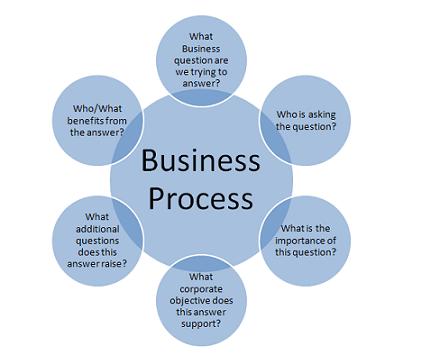Business Process & Technology
A business process or business method is a collection of related, structured activities or tasks that produce a specific service or product (serve a particular goal) for a particular customer or customers. It may often be visualized as a flowchart of a sequence of activities with interleaving decision points or as a process matrix of a sequence of activities with relevance rules based on data in the process.

Business Process Technology
Overview
- There are three types of business processes (citation by August-Wilhelm Scheer and Mark von Rosing)
- Management processes, the processes that govern the operation of a system. Typical management processes include corporate governance and strategic management.
- Operational processes, processes that constitute the core business and create the primary value stream. For example, taking orders from customers, and opening an account in a bank branch.
- Supporting processes, which support the core processes. Examples include Health & Safety, accounting, recruitment, call center, technical support.
- A business process begins with a mission objective and ends with achievement of the business objective. Process-oriented organizations break down the barriers of structural departments and try to avoid functional silos.
- A complex business process may be decomposed into several sub-processes, which have their own attributes, but also contribute to achieving the goal of the super-process. The analysis of business processes typically includes the mapping of processes and sub-processes down to activity/task level.
- Business processes are designed to add value for the customer and should not include unnecessary activities. The outcome of a well designed business process is increased effectiveness (value for the customer) and increased efficiency (less use of resources).
- Business Processes can be modeled through a large number of methods and techniques. For instance, the Business Process Modeling Notation is a Business Process Modeling technique that can be used for drawing business processes in a workflow.
Workflow
- Workflow is the movement of information or material from one activity or worksite to another. Workflow includes the procedures, people and tools involved in each step of a business process. A single workflow may either be sequential, with each step contingent upon completion of the previous one, or parallel, with multiple steps occurring simultaneously. Multiple combinations of single workflows may be connected to achieve a resulting overall process.
Business process re-engineering
- Business process re-engineering (BPR) was originally conceptualized by Hammer and Davenport as a means to improve organizational effectiveness and productivity. It consisted of starting from a blank slate and completely recreating major business processes as well as the use of information technology for significant performance improvement. The term unfortunately became associated with corporate ``downsizing`` in the mid-1990s.
Business process management (BPM)
- Business process management also termed as BPM covers how we study, identify, change and monitor business processes to ensure they run smoothly and can be improved over time. It is a continuous evaluation of existing processes and identification of ways to improve upon it, resulting in a cycle of overall organizational improvement.
Knowledge management
- Knowledge management is the definition of the knowledge that employees and systems use to perform their functions and maintaining it in a format that can be accessed by others. The Gartner Group definition states that Knowledge management is a discipline that promotes an integrated approach to identifying, capturing, evaluating, retrieving, and sharing all of an enterprise's information assets. These assets may include databases, documents, policies, procedures, and previously un-captured expertise and experience in individual workers.
Total quality management
- Total quality management (TQM) emerged in the early 1980s as organizations sought to improve the quality of their products and services. It was followed by the Six Sigma methodology in the mid-1980s, first introduced by Motorola. Six Sigma consists of statistical methods to improve business processes and thus reduce defects in outputs. The lean approach`` to quality management was introduced by the Toyota Motor Company in the 1990s and focused on customer needs and reduction of wastage.
Our distinct services include :
- Material and Documents: We provide real time working documents and materials to our students.
- Free System Access : We have the latest and most up to date platforms deployed on high-end servers that are available remotely and in-class on a 24/7 basis.
- Interview Preparation: We will prepare you for interviews in your specialized area by providing some real time interview questions. We also conduct mock interviews and assist you in preparing a professional resume.
- Placement Assistance: Our placement service division provides job placement support by submitting your resumes to prospective clients and emails you any new job opportunities in the market. However, we do not provide false guarantees on securing any jobs for you. We have a history of several ex-students who have secured excellent jobs based on our WORLD class training approach, implementation of case study projects and post training support.
- Initial Job Stabilization Support: We support our students to get stabilized in their job in the first TWO months. If our students come across any issues, we are there to help them. Students can send an email to us with their issues, our experts will reply back with possible solutions within 24 hours.
- Free Class Room sessions recording: In addition to the e-class training, we will give you authorization to record all of your e-class room training sessions, so that you can go back and review.
Other Courses related
Course registration
Instructor Led Hands-on eClassroom Training.
Key Points of Training Program :
Business Process & Technology Courses, Learn with Online Practice, in-class Seminars, Training and Certification from the list of world-class education trainers. Macropus provides Class Material, Tutorial Curriculum, Demo Videos, Sample Questions, Recommended Books, Tips and Tricks. Get lectures and practical lessons on development and programming to improve technical skills and Students will benefit with Job Placements, Visa.
